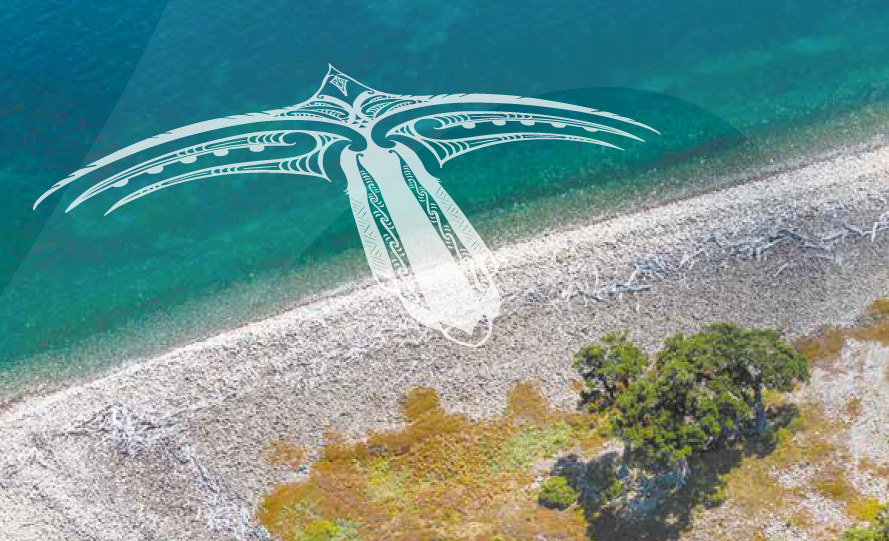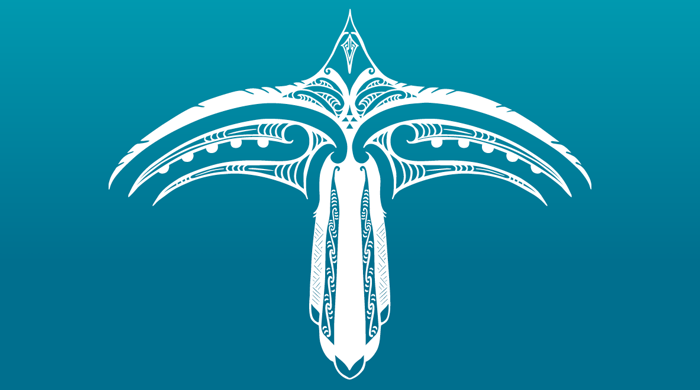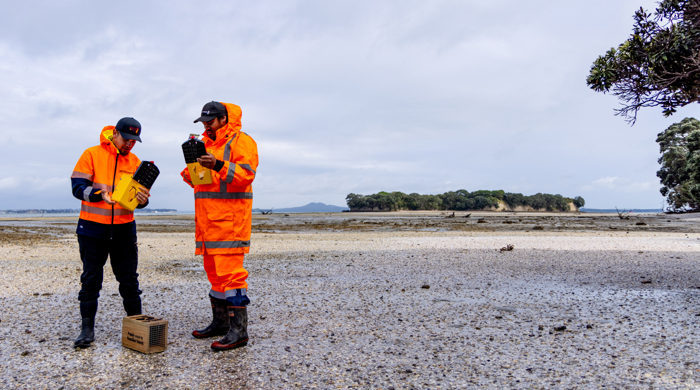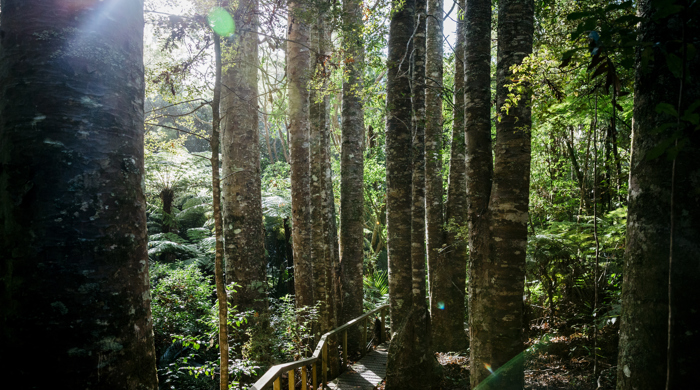
Kaitiakitanga - te mana whenua me te taiao
Kaitiakitanga - mana whenua and the environment
Find out about the unique and enduring kaitiaki (guardian) relationship that mana whenua have with te taiao (the environment) in the Auckland region.

The following information has been provided from a mana whenua perspective. There is some overlap with similar information that we recommend you also look at in Te Haumanu Taiao: Restoring the natural environment in Tāmaki Makaurau.
About kaitiakitanga
The relationship and responsibility mana whenua have as kaitiaki are embodied in 'Haumanu'. This bird-like design is central to the resource Te Haumanu Taiao: Restoring the natural environment in Tāmaki Makaurau.
The intricate patterns within this design express the deep connections between people and nature. They serve as a reminder of our mutual vulnerability and interdependence.
Read the explanation of the intricate designs of Haumanu to gain more understanding of kaitiakitanga.

Whakapapa
The journey through the narrative of whakapapa is a central part of our very existence, our lineage and our genealogy. It links us today to our primal ancestors at the very beginning of time.
Whakapapa binds the spiritual and natural worlds, the animate and the inanimate. This story upholds these connections. of the spiritual and physical realms. From the union of Ranginui and Papatūānuku came the natural world (Te Taiao) and, later, humanity (Te Ira Tangata).
By sharing whakapapa with the natural world, we affirm our interconnectedness and interdependence with all things. People, birds, fish, and even weather patterns are members of the same family, with humans as tēina.
Whakapapa is more than a genealogical record - it is a system guiding behaviour, belonging and responsibilities. It reminds us of our intergenerational duty to protect and preserve whole living systems. This ensures the wellbeing and regeneration of the whakapapa relationships that sustain these systems.
This intricate system of whakapapa relationships is interwoven with mātauranga ā hapū and tikanga which have evolved over generations to guide environmental care.
For mana whenua, caring for the lands and waters to which they are connected through whakapapa is an obligation. This reciprocal relationship grounds mana whenua to Papatūānuku.
Kaitiaki cannot be filled by a group anywhere because the status of kaitiaki stems from long tribal associations. Only tangata whenua can be kaitiaki, and can determine the form and structure of kaitiaki.
Minhinnick, N. (1989) Kaitiaki. Print Centre, Auckland
Mauri and mana
Whakapapa provides both living and non-living things with mauri - the vital essence, life force or life principle. In te ao Māori, mauri is the essential quality and vitality of a being or entity.
Mauri can be denigrated and reduced. As kaitiaki, mana whenua are entrusted with maintaining mauri. If this role is neglected, the mauri of the spiritual and physical relationships they are born into diminishes, along with their mana - authority, status and prestige.
We are mortal, yet subject to the mauri and mana of our kaitiakitanga in the cosmos. If our kaitiaki has insufficient mauri and mana, our role in the cosmos will fade and vanish. Our whakapapa will be broken and lost. The cosmos will continue and the relationships amongst the natural realms will adapt and endure in our absence.
Whakapapa connects all of us, tying us together. It reminds us of our mortal position in the natural world and how its relationships constitute and sustain us. This reminder needs to be acted upon if we are to continue to have our tūrangawaewae and for humanity to thrive.
Kaitiakitanga in practice
Kaitiakitanga is inherently adaptive and deeply connected to place. Each rohe is a system that meets the needs of its people from rere ki uta, rere ki tai. Features of the landscape incorporate all aspects of te ao Māori including defensive pā sites or papakāinga, māra kai and the waterways and ngahere that provided kai and other resources.
This abundant cultural landscape is subject to collective decision making of the kaitiaki.

Tikanga
The decisions made by kaitiaki are guided by tikanga, an ethical system of customary practices that protect the wellbeing of all life. Tikanga bridges the natural and spiritual worlds.
One key tikanga practice is rāhui. Beyond physical restrictions, rāhui has a spiritual dimension, safeguarding the mauri of resources, people or places. Other kaitiaki activities include habitat restoration, enhancement and reseeding efforts.
Across Tāmaki Makaurau, several rāhui are in place. For example, a rāhui was placed over Te Wao Nui a Tiriwa to address kauri dieback. Refer to waitakererahui.org.nz to learn more about this initiative.
The ongoing development across Tāmaki Makaurau significantly impacts the practice of kaitiakitanga. It adds complexity to the mahi of kaitiaki, who work tirelessly to monitor, preserve and protect the health and wellbeing of te taiao.

Related information
- Te Tāruke-ā-Tāwhiri: Auckland’s Climate Plan
Has had significant mātauranga input from mana whenua and describes how to maintain the wellbeing of the unique landscapes across Tāmaki Makaurau / Auckland from a te ao Māori perspective that may help provide additional context for perspectives regarding conservation activity. - Te Ora ō Tāmaki Makaurau Wellbeing Framework
A wellbeing framework developed by the Auckland Council Mana Whenua Kaitiaki Forum in response to Te Tāruke-ā-Tāwhiri. It describes three dimensions of sustaining the natural balance and increasing the mauri of te taiao: Ngā Aho Taiao, Ngā Aho Whenua and Ngā Aho Tangata. - Hīkina te Wero: Environment Action Plan (PDF 919KB)
Auckland Transport (AT) together with mana whenua developed this plan to ensure their transport network protects and restores the environment. Of particular interest is the mana whenua specific pages 10 – 11 that cover their role as kaitiaki, how that is guided and their interconnected world view, and outlines te ao Māori principles that guide AT’s work. - Shoreline Adaptation Plans (SAPs)
The SAPs help council and community plan for the future of Auckland’s 3200km of shorelines (beaches, cliffs, harbours and estuaries) in response to the impacts of climate change, erosion and flooding. Each SAP includes ongoing consultation with local iwi and several months of local community engagement to helps understand how coastal areas are used and valued. - Te Rautaki Wai ki Tāmaki Makaurau: Auckland Water Strategy 2022 - 2050
Auckland’s Water Strategy builds on the Our Water Future - Tō Tātou Wai Ahu Ake Nei public discussion document which set a high-level vision for Auckland’s waters: ‘te Mauri o te Wai o Tāmaki Makaurau - the life-sustaining capacity of Auckland’s water - is protected and enhanced’. - Te Mana o te Wai concept
Te Mana o te Wai recognises the mana and mauri of water. It also encompasses the relationship between water, the wider environment and our communities. It is a requirement of the government's National Policy Statement on Freshwater Management (NPS-FM) to 'give effect' to Te Mana o te Wai. Auckland Council has responsibilities under the NPS-FM and is working with mana whenua and communities to understand what Te Mana o Te Wai means in Tāmaki Makaurau / Auckland. Watch the brief introductory webinar about Te Mana o te Wai prepared by the Ministry for the Environment.



